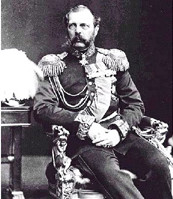
Alexander II birthday anniversary
On April 17 (29), 1818 in the family of Nikolai Pavlovich and the grand duchess Alexandra Feodorovna was born a son, Alexander. The older brothers of his father, Emperor Alexander I and tsesarevich Konstantin, did not have any heirs in the male line. Thus Alexander Nikolaevich was a long-awaited successor of Romanov’s family.
The future Emperor Alexander II was well educated. Poet V. A. Zhukovsky was his mentor; among the tutors: public figure and statesman M. M. Speransky (legislation), geographer and ethnographer K. I. Arseniev (statistics and history), archpriest Gerasimus Pavsky (religion and holy history), Finance Minister E. F. Kankrin (economy), diplomat F. I. Brunov (foreign policy), German botanist K. B. Trinius (natural history). Military instructor of Alexander was Captain K. K. Merder, the main educator – General P. P. Ushakov. The heir’s personality had formed under the influence of his father who wished his son to be a military man and also of his tutor who wanted to make the future monarch an educated man. Both influences left a deep trace on the heir’s character, inclinations, world outlook and impacted his reign. By nature Alexander had an excellent memory, a sober mind, was responsive and sympathetic, cheerful and benevolent.
From 1834 to 1842 Alexander Nikolaevich was sequentially made a member of the Senate, Holy Synod, State Council and Ministers Committee. In 1837 he travelled over the European part of Russia, visited Transcaucasia, Western Siberia. In 1838-1839 he travelled over Europe. At the same time he was promoted in his military career. In 1836 he was given the rank of major general, in 1844 – of general, and in 1849 Alexander became the Head of military and education institutions. During the Crimea campaign of 1853-1856 when Petersburg province was declared in martial law, the heir to the throne commanded all the capital’s troops. In 1841 Alexander married the princess of Grand Duchy of Hesse and Darmstadt Maximiliana-Wilhelmina-Augusta-Sophia-Marie known in Russia as Maria Alexandrovna.
In 1855 Alexander II mounted the throne and reigned until 1881. On March 1 (13), the Emperor was mortally wounded by an explosive thrown at him on Catherine Canal embankment in Petersburg.
2 years later, in October 1883, by decree of Emperor Alexander III in St. Petersburg on the place where Alexander II had been mortally wounded, was built the Church of the "Savior on Spilled Blood” (Cathedral of the Resurrection of Christ) as a memorial to the emperor-reformer and a symbol of repentance of the Russian people of his murder.
Lit.: 1 марта 1881 г.: Казнь императора Александра II (документы и воспоминания). Л., 1991; Венчание с Россией: Переписка великого князя Александра Николаевича с императором Николаем I. 1837 г. / Сост. Л. Г. Захарова, Л. И. Тютюнник. М., 1999; Император Александр Николаевич. Черты из его жизни // Русская старина. 1891. Т. 70. № 6. С. 719-726; К 125-летию гибели императора Александра II. [Электронный ресурс] // Седмица.Ru. 2008-2019. URL: http://www.sedmitza.ru/text/404898.html; Платонов С. Ф. Краткий обзор времени императора Александра II и великих реформ // ВикиЧтение. URL: https://document.wikireading.ru/30399; Пребывание императора Александра II в Риме. (1838-1839) // Исторический вестник. 1881. Т. 2. № 6. С. 312-320; Черта из жизни императора Александра II / Запись Д. Щербачёва // Исторический вестник. 1890. Т. 39. № 2. С. 481-485.
Based on the Presidential Library’s materials:
Alexander II (1818–1881) // House of Romanov. The Zemsky Sobor of 1613: [digital collection];

